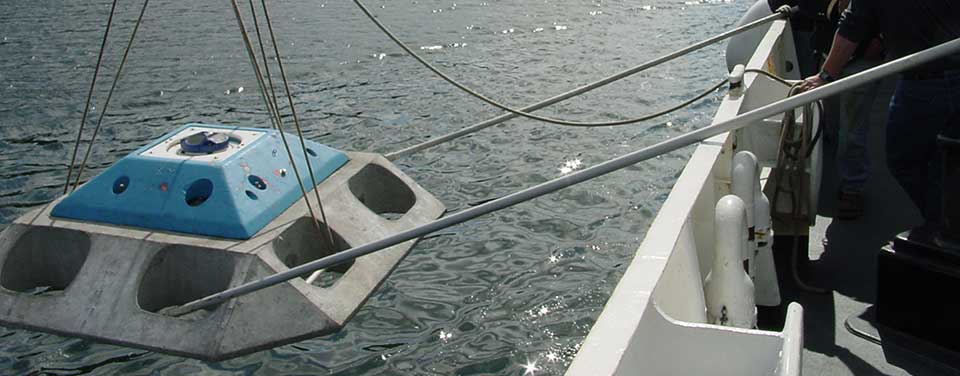How do we monitor currents?
To measure currents, you need three basic tools — an observer, a floating object or a drifter, and a timing device.

Crew from the NOAA Ship Rainier> use an Acoustic Doppler Current Profiler to assist in a current survey of waters near Sitka, Alaska. Results from current surveys are used to improve tidal current predictions and to support new operational forecast models.
An observer stands on a ship, throws the drifter into the water, and then measures the time that it takes that object to move along the side of a ship. As technology improved over time, oceanographers began using mechanical current meters. A ship would deploy a meter and usually some sort of rotor would turn and measure the currents. This is still the basic process today; however there are more accurate and sophisticated instruments.
Today in the open ocean, a drifter is similar to a buoy in the water that may be equipped with global positioning system technology or satellite communications that would relay data and information. Drifters can also submerge for long periods of time to measure ocean currents at a particular depth. The drifter would then resurface occasionally to send a signal with its data and position to observers on the land.
In addition to buoys, there are other tools that are used to monitor currents. The Acoustic Doppler Current Profiler is commonly used to measure currents. It is normally deployed on the seafloor or attached to the bottom of a boat. It sends an acoustic signal into the water column and that sound bounces off particles in the water. The instrument can calculate the speed and direction of the current by knowing the frequency of the return signal, the distance it traveled, and the time it took for the signal to travel.
Many oceanographers also use radio antennas and high frequency Radio Detecting and Ranging systems (radar) to measure surface ocean currents. Similar to the Acoustic Doppler Current Profiler, these shore-based instruments use the Doppler effect to determine when currents are moving toward or away from the shore or to measure the velocity of a current.
At NOAA, oceanographers use knots to measure current speed. The term knot is defined as one nautical mile per hour. One nautical mile is equal to 1.85 kilometers. One knot is also 51.44 centimeters per second.
Search Our Facts
Get Social
More Information
Last updated: 06/16/24
Author: NOAA
How to cite this article